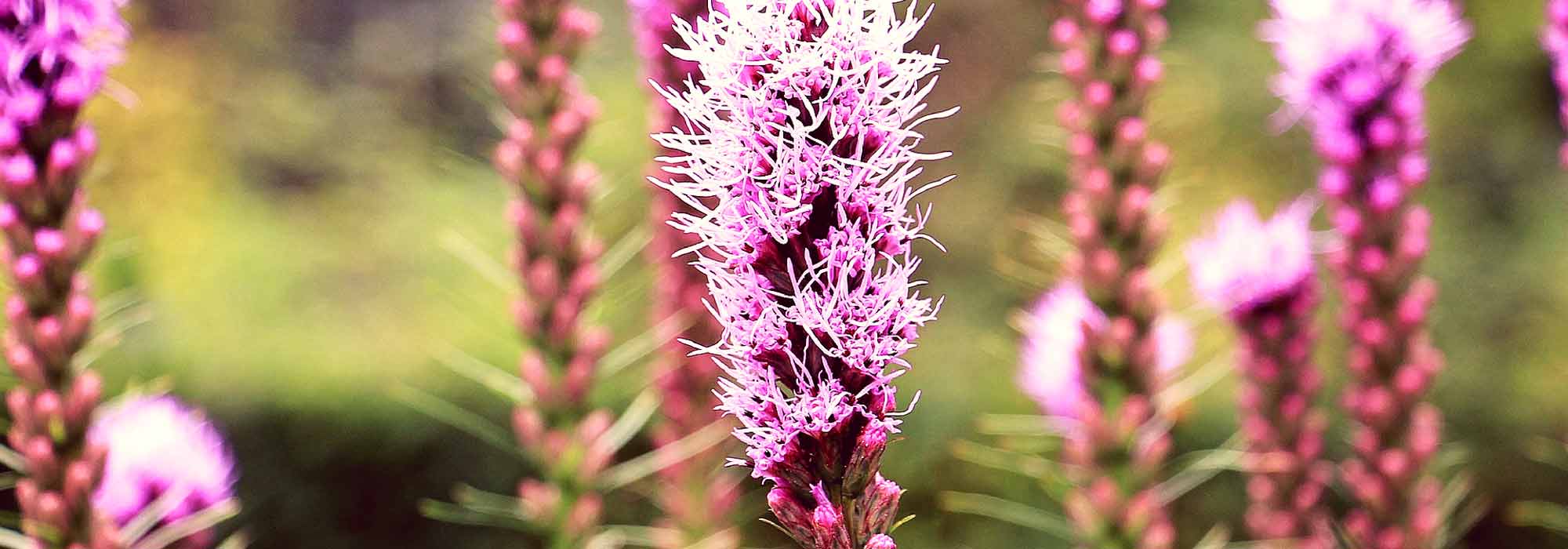
Button snake, Liatris spicata: planting and care
Contents
Liatris, or Blazing Star, in a nutshell
- Liatris spicata is a hardy bulbous perennial that boasts summer flowering in lilac, pink, or white spikes resembling feathers
- Its finely dissected foliage provides an elegant yet very natural appearance
- Very hardy, even in the coldest regions, it is a very vigorous young plant!
- It grows easily in full sun in poor, well-drained soil, remaining nicely cool
- Very graphic, Kansas Feather structures country borders all summer long
A word from our expert
Still relatively unknown, the Kansas Blazing Star or Liatris deserves a prominent place in the spotlight of all countryside or slightly wild gardens! With its elegant flowering displayed in the form of long feathery spikes and its beautiful herbaceous foliage, the Kansas Blazing Star adorns itself with pastel shades of pink, white, or purple, offering an airy refinement that enchants gardens throughout the summer as well as bouquets.
From the white liatris or Liatris spicata ‘Alba’ to the lilac purple spikes of Liatris spicata ‘Kobold’, the blazing star flower of Liatris has the unique characteristic of blooming first from the top, giving this bulbous perennial a charmingly shaggy appearance.
Beneath this apparent delicacy, this beautiful American plant possesses a great hardiness, withstanding our rather cold winters often well below -15°C!
Easy to grow, Liatris requires only a well-drained, cool to moist soil during the summer and a nice warm spot in the sun, which is essential for abundant flowering.
This perennial with its very original summer flowering in mauve or more rarely white will bloom for many months in your beds, borders, rockeries, or pots. The Liatris spicata will even thrive by the edge of a pond.
Quickly create a colourful countryside setting with our Kansas Blazing Stars and follow our tips to multiply them or plant the bulbs of Liatris spicata.
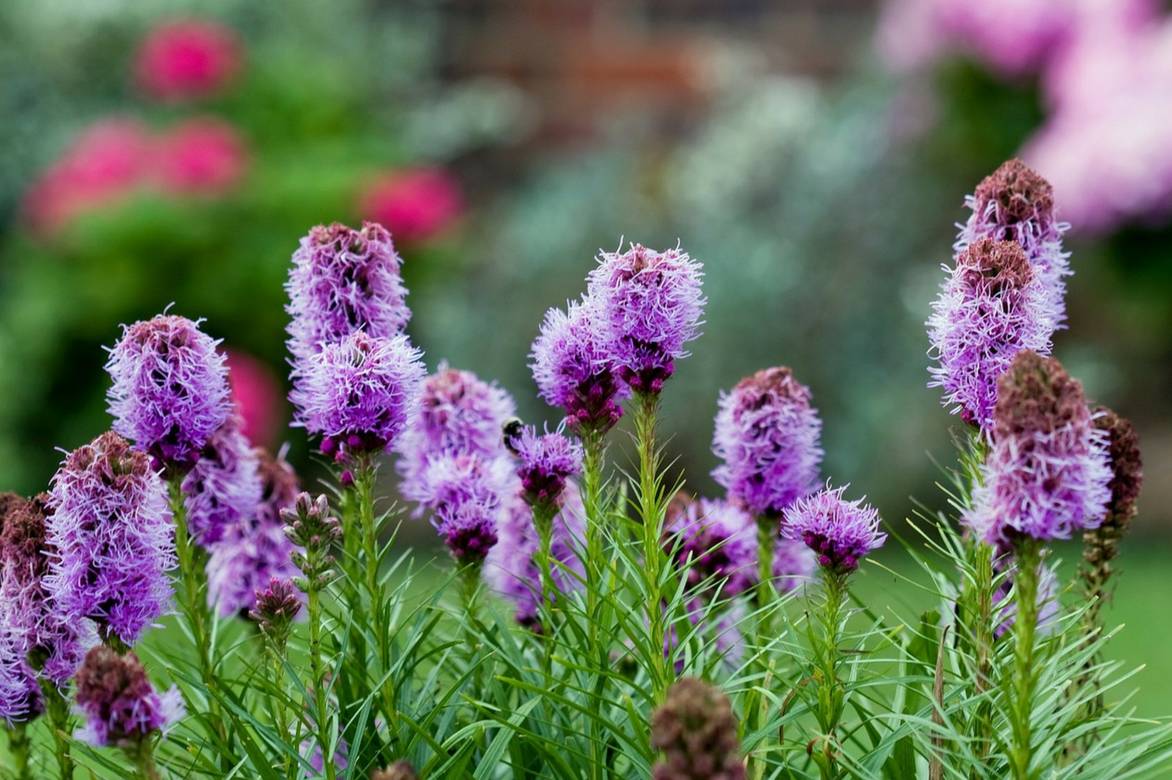
Pretty mauve tufted flowers of the Liatris spicata.
Description and botany
Botanical data
- Latin name Liatris
- Family Asteraceae
- Common name Button snakewort, Kansas Blazing Star, Spike Blazing Star, Prairie gay feather
- Flowering From June to September
- Height 0.40 to 1.20 m
- Exposure Sun, partial shade
- Soil type All, well-drained
- Hardiness -15°C
Originating from the United States, the Liatris or Kansas Blazing Star from the Asteraceae family naturally grows in meadows, open woods, and on dry, rocky soils. The genus includes approximately 40 species of bulbous perennial plants, among which Liatris spicata or Spike Blazing Star is the most common species in our gardens. Most often purple, it is available in a few pink and white varieties.
Less commonly encountered is Liatris pycnostachya, the tallest species in the genus, with stems reaching up to 1.50 m in height, and Liatris scariosa with its frizzy flowers.
Liatris forms a beautiful upright bushy clump supported by a fleshy, half-rhizomatous, half-bulbous stump. Capable of covering the ground over 50 cm, it rises from 0.70 cm to 1.20 m high depending on the varieties. Relatively slow to establish, it requires about two to three years to fully develop.
From a rosette of linear basal leaves, 40 cm long, long bare and rigid stems emerge in spring. The linear and fine foliage, a beautiful bright green, resembles that of grasses or evokes herbs. As one moves up these stems, the cauline leaves, arranged alternately, become fewer, smaller, and lanceolate. Deciduous, the foliage disappears with the first frosts.
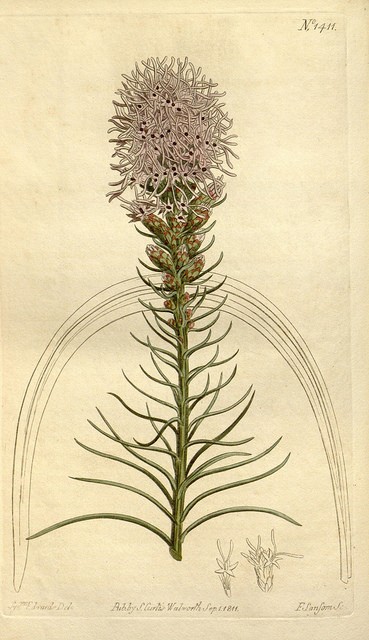
Liatris spicata – botanical illustration
From June to September, continuously, numerous floral stems emerge from this grassy and gramineous clump, rising sometimes to nearly 1.20 m above the ground for the tallest flower spikes. They bear feathery inflorescences in dense spikes that uniquely open first from the top, taking the shape of a candle. Ranging from 45 to 70 cm in length, these heads consist of about twenty tiny flowers with filaments measuring 0.5 to 1 cm long. Their fluffy appearance makes them so reminiscent of feather dusters that this beautiful American perennial has been nicknamed the “Kansas Blazing Star.”
The floral spikes in shades of pinkish violet, lilac, purple, or more rarely white with the characteristic feathery appearance of Liatris, make beautiful cut flowers that are very decorative in fresh or dried bouquets; they last about ten days in a vase.
Not fragrant, but melliferous, the flowers renew continuously throughout the summer until autumn within the borders, attracting numerous pollinating insects, butterflies, and bees.
Flowering is followed by the formation of pubescent fruits topped with feathery bristles that will nourish birds in winter. These light brown candles suspended from their inflexible stems will extend the decorative effect during the cold season.
Liatris is quite hardy in our regions, withstanding temperatures often below -15°C, and can be cultivated in all areas. It grows in full sun in light, sandy, very well-drained soils but moist to wet and low in fertility. It tolerates partial shade in the hottest regions. Liatris spicata, the most widespread in our gardens, particularly enjoys more humid locations and will thrive by the edge of a water feature.
With its tall, graceful stems and light, tousled silhouette, the Liatris adds a rustic and structuring touch to natural gardens. It is perfect everywhere: in large rockeries, perennial beds where it lightens the blooms, or summer borders to which it brings breath, movement, and verticality. It can also be planted in pots on balconies and terraces.
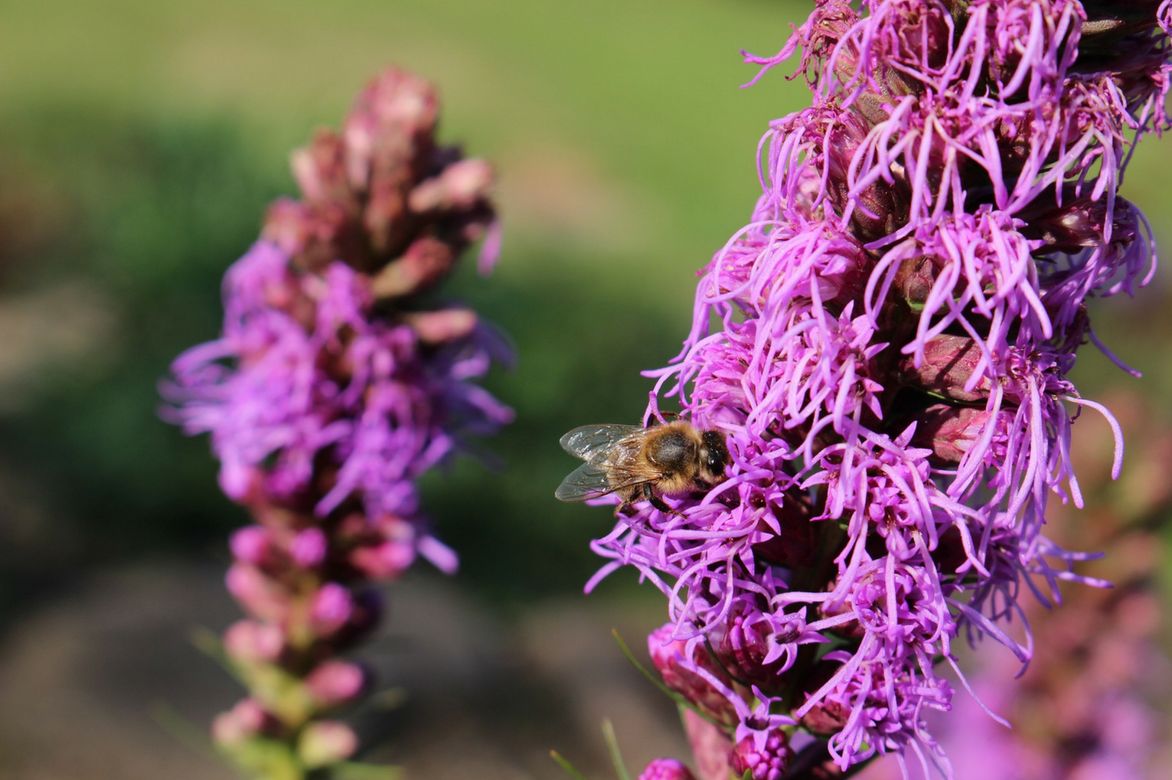
Melliferous, the flowers of Liatris are highly appreciated by bees and butterflies.
Read also
Echinaceas : sowing, growing and careMain species and varieties
If the genus Liatris includes around 40 species, it is the Liatris spicata with purple spikes that is most commonly found in our gardens. It has given rise to several cultivars with flowering ranging from pure white (‘Alba’) to bright pink (‘Kobold’). The Liatris pycnostachya, whose stems can reach up to 1.5 m in height, and the Liatris scariosa with its delightfully feathery reddish-purple flowers are encountered less frequently.
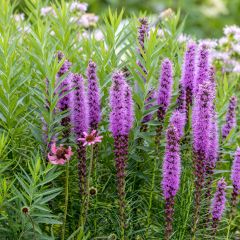
Liatris spicata
- Flowering time August to October
- Height at maturity 80 cm
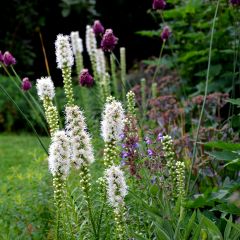
Liatris spicata Alba - Dense Blazing star
- Flowering time August to October
- Height at maturity 90 cm
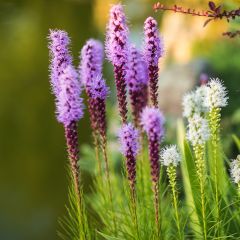
Liatris spicata Kobold - Dense Blazing star
- Flowering time July to October
- Height at maturity 50 cm
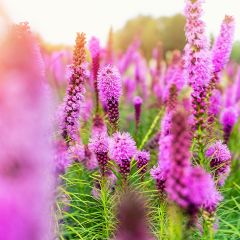
Liatris spicata Floristan Violet
- Flowering time August to October
- Height at maturity 90 cm

Liatris spicata Floristan White - Dense Blazing star
- Flowering time August to October
- Height at maturity 90 cm
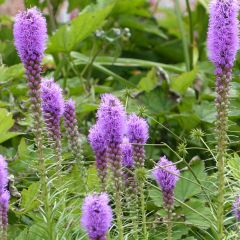
Liatris spicata Seeds
- Flowering time July to October
- Height at maturity 70 cm
Discover other Liatris - Kansas Blazing Star
View all →Available in 0 sizes
Available in 1 sizes
Available in 1 sizes
Available in 1 sizes
Available in 1 sizes
Available in 1 sizes
Available in 1 sizes
Available in 1 sizes
Planting
Where to plant the Kansas Blazing Star?
Native to the plains of the eastern and central United States, the Liatris or Kansas Blazing Star acclimatises easily in all our gardens, withstanding negative temperatures down to at least -15°C.
While it prefers warm sunny exposures essential for abundant flowering, it will tolerate partial shade in southern regions.
Easy to grow, it thrives in light, sandy, even poor soil, fresh to moist during the growing season but well-drained. The Liatris spicata shows a preference for moist but not waterlogged soils and will appreciate being near a pond or water feature where it can benefit from the ambient humidity. It dislikes heavy, compacted, and poorly drained soils in winter: waterlogged soil can compromise its resilience, as its roots rot easily.
Taller than wide, it typically occupies 30 to 50 cm in width at maturity for a minimum height of 70 cm, so provide it with a location where it can showcase its verticality.
Very graphic, the Liatris creates a green and floriferous bush throughout the summer, ideal for adding relief, lightness, and height to the backgrounds of slightly blurred summer flower beds, large rockeries, or mixed borders. With its upright appearance, it has a very structuring effect. It can also be grown in abundant flower pathways or in pots to brighten up sunny terraces and balconies.
When to plant Liatris?
The Kansas Blazing Star is best planted in spring from March to April or in autumn from September to November, avoiding frost periods.
How to plant the Kansas Blazing Star?
In the ground
- In buckets
For a beautiful airy effect in a flower bed, plant the liatris in buckets in groups of 5 to 7 per m², spacing the plants 20 to 25 cm apart in all directions. To form a lovely green and flowering bush throughout the summer in the middle of a short grass meadow, for example, install at least ten Liatris plants. In heavy, compact soil, make a good addition of compost to lighten it and improve drainage.
- Dig a hole 2 to 3 times the volume of the bucket
- Loosen the soil deeply to properly aerate it
- Add river sand or gravel to the bottom of the hole
- Add a good shovelful of compost
- Backfill
- Water generously
- Mulch with compost to keep the roots cool during summer
In pots
The substrate must be very draining to avoid stagnant moisture. Plant the Liatris in full sun in a large pot of at least 50 cm in diameter in a mix of garden soil and compost.
- Spread a good layer of gravel or clay balls at the bottom of the pot to facilitate drainage
- Plant the bucket upright
- For bulbs, bury them 10 cm deep, covering them with three times their height of soil
- Mulch
- Water twice a week during the growing season
When and how to plant Liatris bulbs?
The roots of the Liatris or Kansas Blazing Star are similar to bulbs, situated between the rootstock and the tubercle. While the plant is mostly sold in buckets, Liatris bulbs can sometimes be found in stores. Ideally, the planting of Kansas Blazing Star bulbs should take place from September to November, outside of frost periods. Planting in March is also possible.
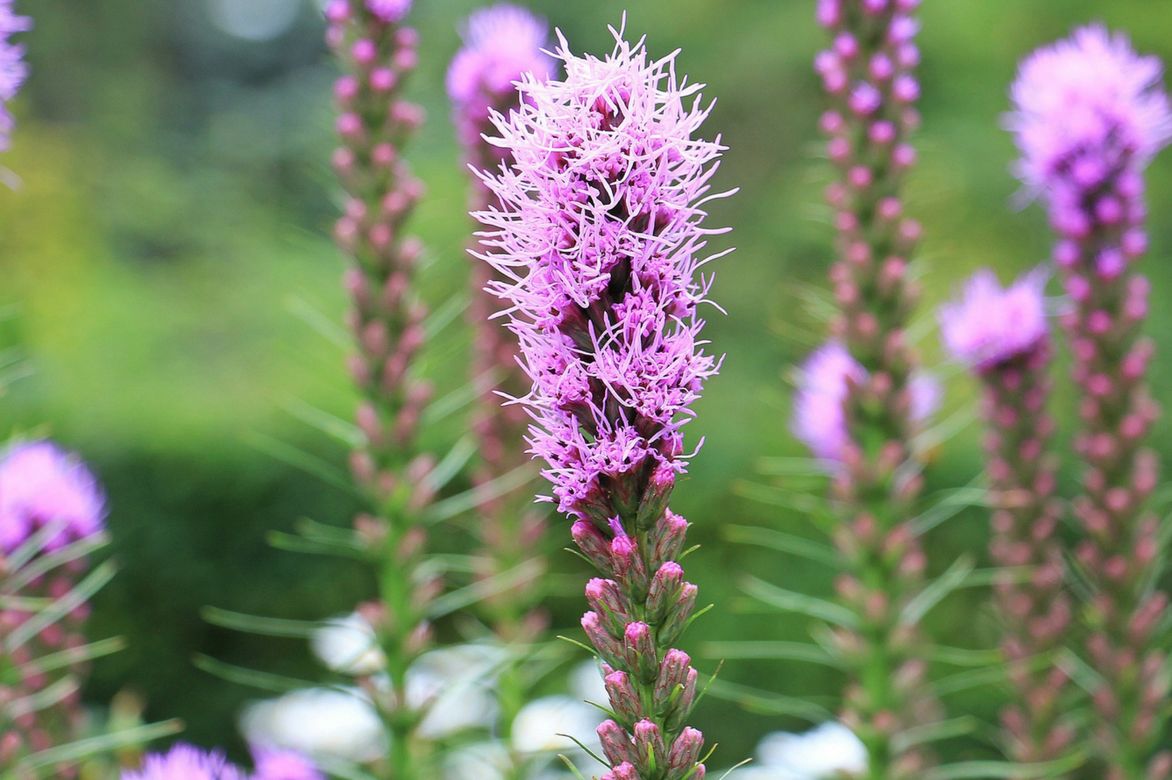
Inflorescence of Liatris spicata.
When and how to sow Liatris seeds?
Sowing seeds harvested from your Liatris in autumn or selected from our Liatris seeds is easy to do. Seeds harvested in autumn should be sown as soon as they are ripe if you haven’t cut all the flower spikes! In packets, sow from March to May. It will only flower in the second year, producing only foliage in the first summer.
Under cover
Sow in trays indoors at a temperature of 18-20 °C, using a light mix of potting soil and sand for the Liatris seeds.
- Cover with a thin layer of substrate
- Press down and water gently
- Keep slightly moist in sunlight until the first shoots emerge after 28 days
- As soon as the seedlings are strong enough (3 to 4 cm tall), transplant them into individual buckets
- Plant out in May in their final position as soon as the risk of frost has passed
Direct sowing
From May to July, sow the Liatris seeds by scattering them in well-amended soil enriched with compost and drained with river sand.
- Cover with a thin layer of potting soil
- Water and keep the soil moist until germination
- Thin out the seedlings to leave at least 40 cm between plants
Care and Maintenance of Kansas Grass
Hardy and vigorous, Kansas Blazing Star requires little care once well established in well-drained soil.
The Liatris spicata, which prefers cool to rather moist soils, should be watered during dry summers. In the first summers, provide regular watering but without flooding it. Just ensure that the soil never completely dries out.
Mulch in May with a good layer of turf to maintain sufficient moisture at the base. Renew this mulch in the height of summer if necessary.
Remove the wilted spikes with pruning shears as they fade to encourage more vigorous regrowth next season: take the opportunity to create fresh bouquets.
In autumn, cut back the faded stems, trim the old dry foliage to promote the growth of new leaves, or leave the dried spikes in place throughout winter and postpone this task until spring, in March.
All aerial parts of the plant disappear in winter: mark its location with stakes if necessary to avoid damaging the clumps when digging and to facilitate the fight against gastropods as soon as growth begins.
Dividing every 3-4 years helps to maintain vigorous plants; liatris, like many perennials, can sometimes tend to decline after 2 or 3 seasons.
Diseases and potential pests
The Liatris, Kansas Blazing Star or Liatris is a rather resilient perennial. While Liatris spicata enjoys moist soil, be careful not to plant it with its feet in water, as it would not survive! It fears heavy, waterlogged soils in winter, which can lead to root rot if the soil is not adequately drained.
The young fresh shoots are endangered by slugs and snails at the start of the growing season. An anti-slug treatment, applied at planting and then every year from February onwards, is essential. Protect it from their attacks with fern manure, a bowl of beer, or barriers of ash, and take inspiration from our slug traps and our 7 effective and natural ways to combat slugs.
Mice can nibble on the roots of the Liatris, which resemble a bulb, making it difficult to combat if you don’t have a cat. Fortunately, we will reveal some effective tips (wire basket, repellent plants…) to protect your bulbs from rodents.
Propagating
To multiply Liatris, dividing clumps in spring remains the simplest method. This should be done when the plant is well-rooted, at least after 4 years of planting. It is a very easy perennial to multiply from our Liatris seeds in packets or harvested in autumn from the garden (follow the instructions above).
- Using a fork, lift the clump without damaging the tuberous roots
- With a sharp, disinfected knife, take pieces of rootstock and replant them immediately in the garden in well-drained soil enriched with compost
Pairing Liatris in the garden
Kansas Blazing Star or Liatris thrives in naturalistic gardens, wild gardens, priest gardens, or cottage-style beds and borders to provide verticality, graphic appeal, and elegance. When planted in groups, it adds contrast, either in pastel shades within mixes of cool mauve, purple, or white, or in yellow/purple complementary combinations.
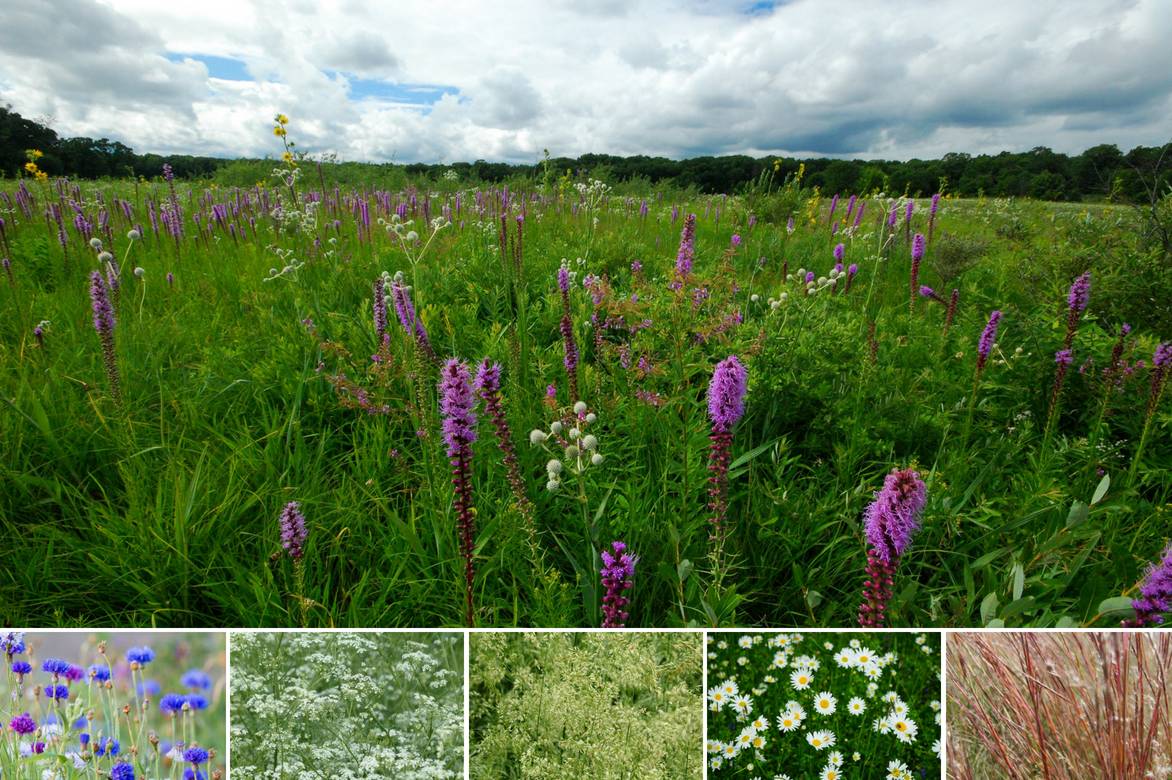
An idea for a wildflower prairie-style association, featuring Liatris pycnostachya. Pair with Liatris spicata and other wild-looking plants such as cornflowers, chervil, grasses like Deschampsia cespitosa or Schizachyrium scoparium, daisies, etc.
In large rockeries or lush beds for stunning scenes of delicacy and lightness, Liatris will be paired with the golden spikes of grasses such as Calamagrostis Brachytricha or Feather Reed Grass, tufted canary grass, the sunny flowers of yellow coreopsis, and the tall stems of Japanese anemones that will take over flowering by the end of summer.
In a wild mixed border, Liatris will form elegant clumps among summer-flowering perennials such as Monardas, Jupiter’s helmets (Aconitum napellus) with their large airy spikes, or knotweeds.
To create a white-pink scene in the height of summer, pair Kansas Blazing Stars with the light panicles of Phlox, hydrangeas, the bristly heads of Echinaceas, and pink Achilleas.
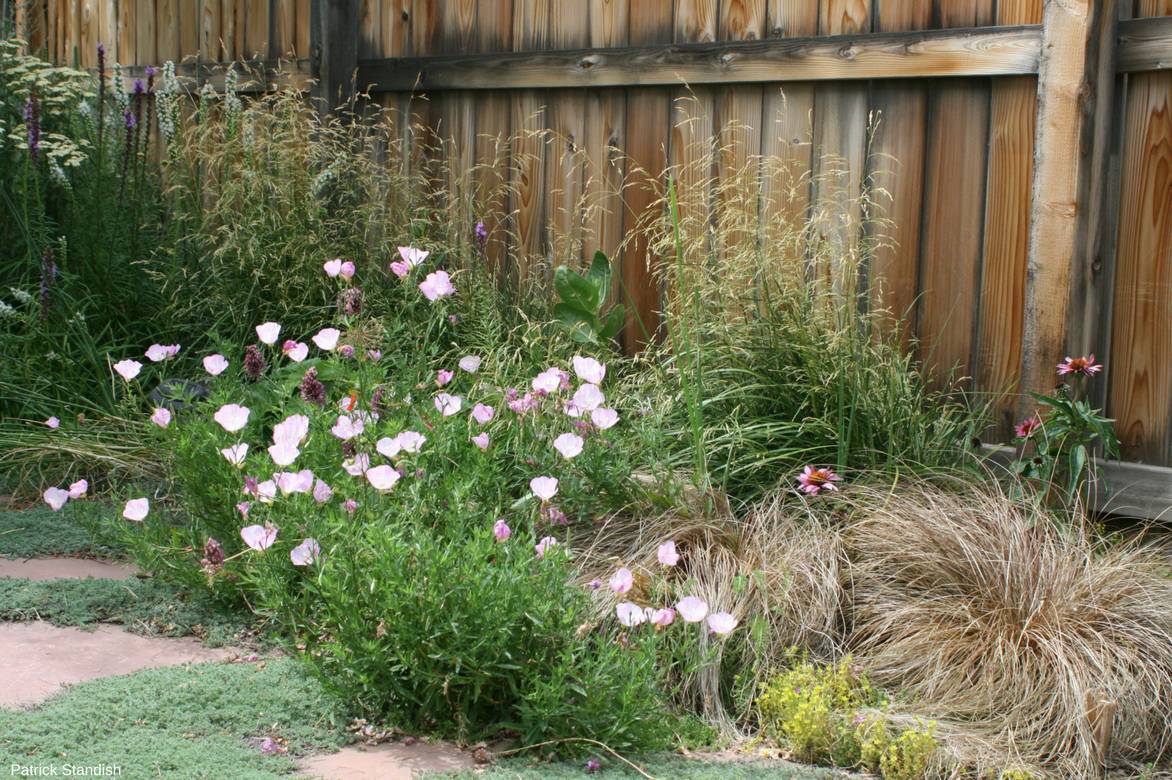
An example of a light association: Liatris spicata and Liatris spicata ‘Alba’, Oenothera speciosa, Thymus pseudolanuginosus, Carex buchananii, Calamagrostis x acutiflora (C. ‘Waldenbuch’ is a variety that takes on beautiful autumn colours), Echinacea purpurea, Sedum acre ‘Yellow Queen’, Allium sphaerocephalon, Achillea millefolium ‘Heinrich Vogeler’.
On the banks of a pond, you can mix the feathery flowers of Liatris with the brightly coloured pink or white plumes of Astilbes for a harmonious tone or irises or bright yellow Lysimachus for a contrasting effect.
In pots, plant Liatris bulbs with dahlias and oxalis.
Useful resources
- Choose your Liatris and imagine a sun-loving naturalist garden!
- Slugs love young Liatris leaves, discover our 7 tips to effectively combat these gastropods!
- Mice delight in the roots of Kansas Feather but here are our solutions!
- Subscribe!
- Contents
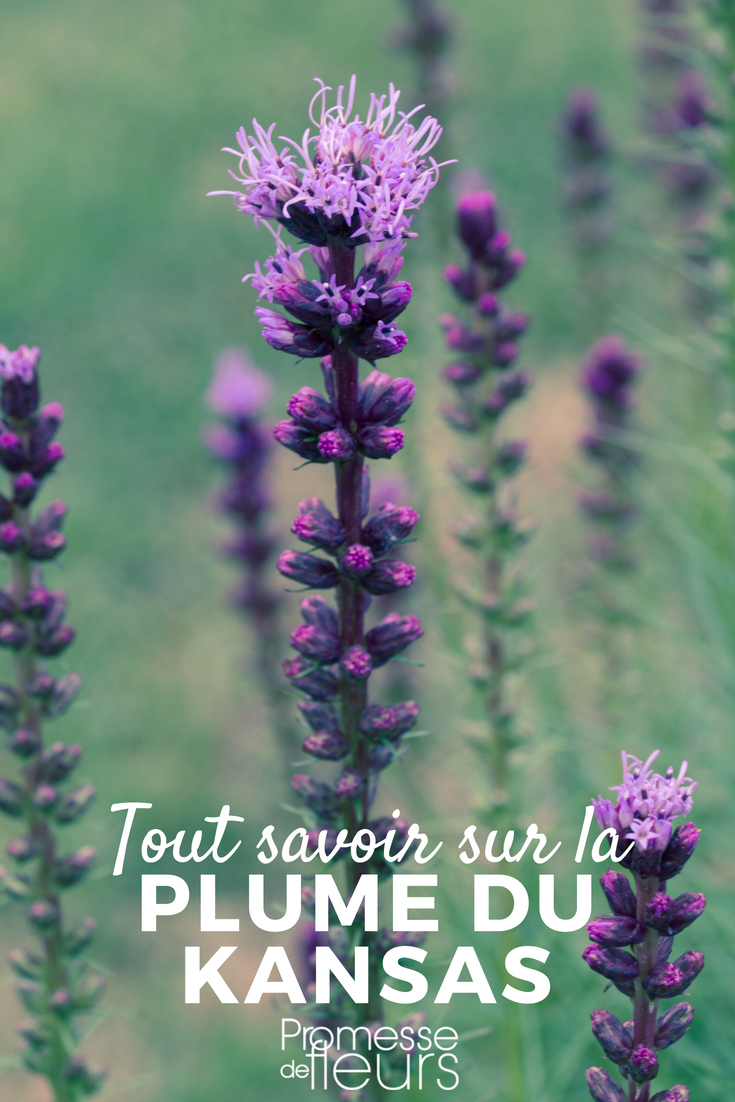
































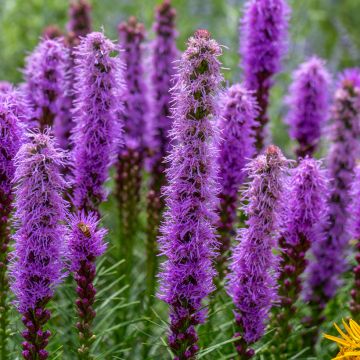



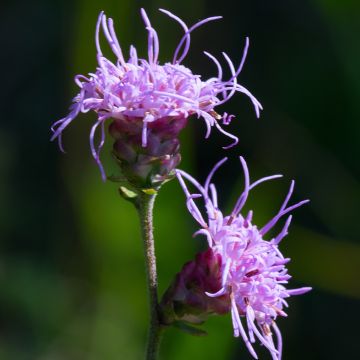


Comments